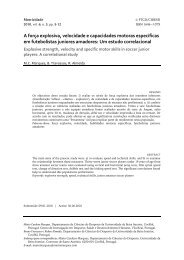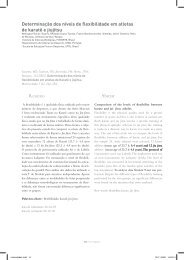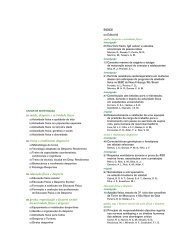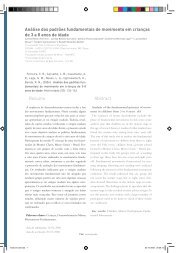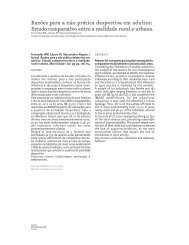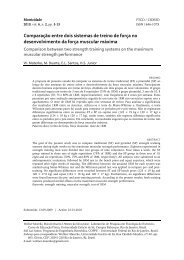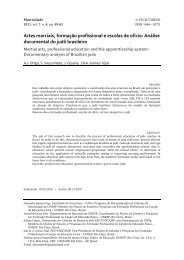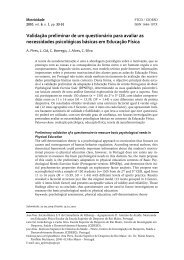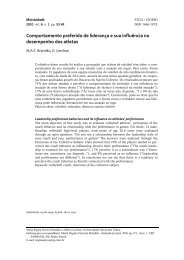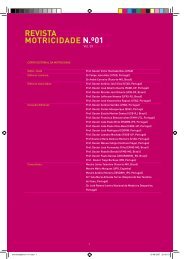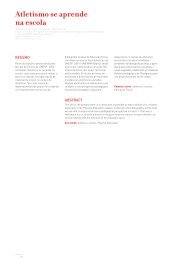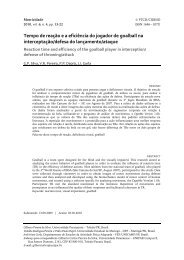revista motricidade
revista motricidade
revista motricidade
- No tags were found...
Create successful ePaper yourself
Turn your PDF publications into a flip-book with our unique Google optimized e-Paper software.
42 | R. van den Tillaar<br />
As the world population is getting older<br />
and older, occurrences of osteoporosis and<br />
osteoporotic fracture are an increasingly<br />
important public health problem (Kannus,<br />
Parkkari, & Niemi, 1995). Norway is one of<br />
the countries that have a high occurrence of<br />
osteoporosis when compared with the rest of<br />
the world. Muscle strength and the ability of<br />
the lower extremity muscles to develop force<br />
rapidly have been found to be the most<br />
common risk factors for falls and hip fractures<br />
in older adults (American Geriatrics Society,<br />
2001; Runge, Rehfeld, & Resnicek, 2000).<br />
Therefore, the prevention of age-related<br />
strength loss and muscle atrophy is a public<br />
health issue (Frontera, Hughes, Lutz, & Evans,<br />
1991; Hughes et al., 2001).<br />
The last decade whole-body–vibration<br />
(WBV) training has been promoted as an<br />
efficient alternative for resistance training.<br />
Subjects use little time on the WBV training<br />
sessions (10-20 minutes) with similar strength<br />
increase as in one hours of resistance training<br />
(Roelants, Delecluse, Goris, & Verschueren,<br />
2004). In WBV training, the subject stands or<br />
moves on a platform that generates a<br />
mechanical stimulus characterized by an<br />
oscillatory motion. The biomechanical<br />
parameters can be given in terms of frequency,<br />
amplitude and magnitude. The amplitude of<br />
the vibration is the extent of the oscillatory<br />
motion (peak-to-peak displacement in mm).<br />
The repetition rate of the cycles of oscillation<br />
determines the frequency of the vibration<br />
(measured in Hz). The acceleration determines<br />
the magnitude of the vibration. The vibrations<br />
can be given reciprocating vertical displacements<br />
in the left and right side of a fulcrum<br />
(Rees, Murphy, & Watsford, 2007), the whole<br />
plate oscillating uniformly up and down<br />
vertically (Machano, Garcıa-Lopez, Gonzalez-<br />
Gallego, & Garatachea, 2010; Raimundo, Gusi,<br />
& Tomas-Carus, 2009; Verschueren et al,<br />
2004) or horizontally (Pel et al., 2009) at<br />
frequencies varying from 5 Hz and 50 Hz.<br />
Earlier studies of WBV training on long<br />
term effect in strength in older women are<br />
limited. Rees et al (2007) found already an<br />
increase of 8% in knee extension strength after<br />
just 8 weeks of WBV training. Machano et al.<br />
(2010) found that after 10 weeks of WBV<br />
training the maximal isometric strength<br />
increased with 38%. Studies over longer<br />
training periods showed some contradictive<br />
results. Roelants, Delecluse and Verschueren<br />
(2004) and Verschueren et al (2004) showed<br />
that 24 weeks and 6 months of WBV training<br />
induced isometric and dynamic knee extensor<br />
strength gains (15-16%) in postmenopausal<br />
women. However, Raimundo et al. (2009) did<br />
not find any significant changes after 8 months<br />
of WBV training on the dynamic strength of<br />
the lower limb. Verschueren et al (2011) found<br />
that after 6 months of WBV training dynamic<br />
strength improved, but isometric strength did<br />
not change. However, in a similar study of<br />
Bogaerts et al (2011) it was shown that<br />
maximal isometric knee extension strength<br />
improved. These differences can be explained<br />
by the different training protocols and<br />
vibration devices used.<br />
Most of the earlier studies used a plate<br />
oscillating uniformly up and down vertically<br />
(Bogaerts et al., 2011; Machano et al., 2010;<br />
Raimundo et al. 2009; Roelants et al., 2004a;<br />
Verschueren et al., 2011). Only Rees et al<br />
(2007) used a reciprocating WBV plate, while<br />
Abercromby et al. (2007a) found that training<br />
with the same load the health risk with upand-down<br />
vibration plates are much higher<br />
than when using a reciprocative vibration<br />
platform). Furthermore, they concluded that<br />
the neuromuscular activity of the leg muscles<br />
with training on a reciprocative vibration<br />
platform was higher than during training on an<br />
up-and-down vibration platform (Abercromby<br />
et al., 2007b). However, to the best of our<br />
knowledge, no prior study has to date<br />
measured the effect of a WBV device that only<br />
vibrated in horizontal direction on strength.<br />
Mostly reasoning of not using these last type of<br />
WBV devices is that it does not induces<br />
vertical accelerations that are transmitted to<br />
the body. Thereby the leg muscles will not be



